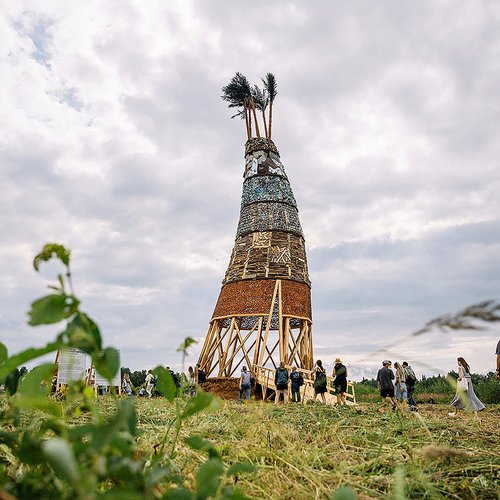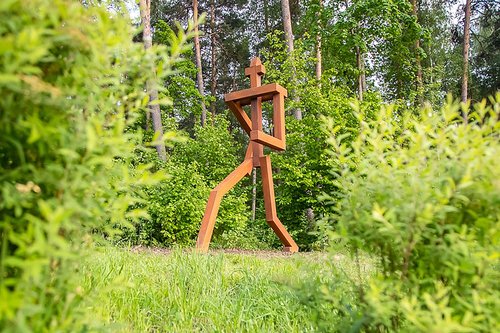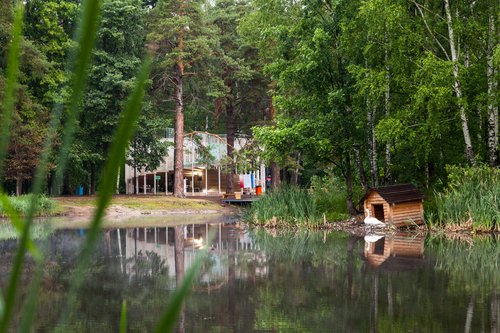Andrey Syailev. Insecto-Phalanster. Part of the Earth Houses project at Archstoyanie-2024. Nikola-Lenivets, 2024. Photo by Ivan Vetrov. Courtesy of Nikola-Lenivets Art Park
Looking for Solidarity in a Russian Bathhouse
Russia’s Archstoyanie land art festival at the end of July was focussed on audience engagement. In this troubled time of division and controversy, its curators called for human connection and interaction as a form of much-needed group therapy.
Reaching Archstoyanie Art Festival is a challenge - when leaving Moscow, you have to navigate 200 kilometres of narrow, twisted roads which are often in a poor state of repair. The festival takes place in and around a village called Nikola-Lenivets on the banks of the river Ugra, a landscape so beautiful that it has been made a National Park. The theme of this year’s festival is ‘We (Us). Since 2006 when it was first staged, nearly two decades ago, the event has grown from an intimate get-together of a few hundred bohemians to a sprawling outdoor party attended by many thousands, with an ever-expanding core group of avid fans and supporters.
So, according to the festival’s curators Anton Kochurkin and Yulia Bychkova, a moment for introspection has arrived. The quest for togetherness, according to Kochurkin, is especially important “in an era of misunderstandings, when old agreements have been broken, and new ones have yet to be found”. In an increasingly polarized society, the question of who “we” are becomes crucial.
One of the festival’s programmes, a series of interactive theatrical master classes, was called ‘Find Your Crowd’ (ironically, the title references the ‘Join Your Crowd’ slogan from ubiquitous advertising posters urging residents of Russian cities to enlist in military service). The festival organizers invited thirty like-minded institutions, companies and self-organised communities to pitch a camp and offer the audience their own interactive programmes. Visitors could connect with each other and nature by taking part in a host of activities from playing in a big sandpit to building an outhouse using sticks and ropes. The audience could even suggest their own group activities – the most popular one was a midnight naked swimming session in the Ugra River. Camps were introduced at the 2023 festival and critics compared it to Burning Man in the Nevada desert, known for its unbridled creativity. This year, the festival acquired a relaxed DIY vibe where the process seemed to be more important than the result: at Potap’s Tower Camp, for instance, visitors built a tower under the guidance of Potap, a person with short-term memory loss. Potap would change the design of the structure every morning, forgetting his previous plans – a timely metaphor for life in the 2020s.
Andrey Syailev (b. 1982), an artist from Samara, known for his inventive site-specific installations and interventions on the streets of several Russian cities, has created a utopian project called ‘Earth Houses’ that encourages humans to connect with bees, birds and plants. In different edges of the forest, Syailev built three tall, skyscraper-like structures made from reclaimed materials, mostly old doors and windows (a homage to Alexander Brodsky (b. 1955), who also used old doors in his 2009 ‘Rotonda’, which later became an iconic symbol of Nikola-Lenivets Art Park itself). The first installation, ‘Insecto-Phalanster’ serves as a giant beehive, which people can visit after putting on protective overalls. The amplified buzzing of the bees is transmitted through loudspeakers all over the surrounding meadow. A short walk away through a thicket, ‘Birds’ Belltower’ tweets and chirps with pre-recorded birdsong. When climbing the structure, visitors inadvertently activate hidden speakers equipped with motion sensors. The artist hopes that real birds will inhabit the tower, lured by the sounds and by seeds and berries that the climbers bring from the structure’s lowest level and leave in bird feeders hanging all along the steep narrow staircase leading to the top. The journey of a curious nature-lover culminates in ‘Nature’s Theater’, where live potted plants from the local region are placed on different levels and visitors can sit next to them and enjoy a site-specific piece of music by well-known St Petersburg composer Vladimir Rannev (b. 1970). Here, hidden loudspeakers are activated when you sit down. The more seats that people occupy, the more different tunes begin playing simultaneously in a strange, mind-boggling harmony. The concept of ‘connecting with non-human agents’ behind this all might seem a bit clumsy and heavy-handed at times, but nevertheless, Syailev’s creations retain some of the original spirit of Nikola-Lenivets. A trademark being absurd, gigantic, climb-at-your-own-risk structures made from cheap and perishable materials, which boldly reach for the sky.
The mastermind behind many of these structures, some still visible today, and some already rotting away, having been burned down or disassembled, is the artist Nikolay Polissky (b. 1957), the pioneer of Russian land art and the founder of Archstoyanie. He works together with Nikolo-Lenivetskye Promysly, a workers’ cooperative staffed mostly with locals. This year, for the first time in five years they created a new object for the Festival. Called Banya-Forum (Bathhouse Forum), it was a collaboration with Anton Kochurkin (b. 1977), an architect and curator of the Festival, who helped Polissky with the technical specs of what is in essence a real banya. Artworks in Nikola-Lenivets live complicated lives of their own, bending to one side, rotting away, burning to ashes, miraculously resurrecting, changing places or evolving into something else. Banya-Forum is no exception. For this project, Polissky used columns woven from hazel twigs, made for his solo exhibition Russian Antiquity at GUM-Red-Line Gallery in Moscow in 2021.

Archstoyanie-2024. Nikola-Lenivets, 2024. Photo by Ivan Vetrov. Courtesy of Nikola-Lenivets Art Park
In Russia, as in ancient Rome, a bathhouse is a place for serious meetings, conversations and negotiations, where big-time deals are made amid the clouds of steam (or over a glass of vodka afterwards). “There is a certain pathos in it that appeals to me”, Polissky said. His banya is a tent made from heat-resistant transparent plastic, where bathers sit on wooden podiums of various heights, like a quirky collection of living and breathing Roman statues, dressed in bathing suits for the sake of propriety. “This banya is a place of both corporal and spiritual purity”, the artist noted.
Throughout the festival, the bathhouse hosted lectures, discussions and collective meditations. During a sound-healing session I happened to attend, solemn bath attendants were chanting, playing Oriental musical instruments and waving branches of birch and oak in the air and over the bathers’ sweating bodies, to the delight of other visitors who wandered outside, taking videos on their phones. The bathers themselves, if not too immersed in a trance, could leisurely watch the moving of clouds and trembling treetops through the plastic roof. From the outside, the structure looks much like a DIY hothouse, typical for Russian dachas and peasant homes, so throughout the session I felt more and more like a tomato, gradually reddening in its plastic-covered home. “I feel like a dumpling”, another visitor commented. Can collective experiences like that one lead to a new unity and deeper understanding between people, or do they just offer a fleeting moment of escape from harsh realities? Hopefully, in either case, efforts were not in vain.













